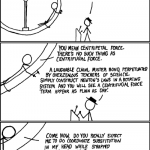density
Dear Mythbusters. I hope you know that I think you are awesome. I know you are not scientists, but rather master robot builders. I respect that. I envy your robot-building abilities. Please forgive me for pointing this out - but even if a tree is 90% air, that does not mean a ball has a 90% probability of passing through it.
For those of you who are unaware, in the last episode of MythBusters, they explored the idea that a golf ball should pass through a tree 90% of the time. What if they were to test following alternative myth:
*A golf ball has a 90% chance of passing through something…
On a previous episode of The MythBusters, Adam and Jamie made a lead balloon float. I was impressed. Anyway, I decided to give a more detailed explanation on how this happens. Using the thickness of foil they had, what is the smallest balloon that would float? If the one they created were filled all the way, how much could it lift?
First, how does stuff float at all? There are many levels that this question could be answered. I could start with the nature of pressure, but maybe I will save that for another day. So, let me start with pressure. The reason a balloon floats is because the air…
One of the worst teaching tools physicists use (and they almost all do it) is to tell students,
There's no such thing as centrifugal force.
What can you do when the top physics education website says, "It is important to note that the centrifugal force does not actually exist. We feel it, because we are in a non-inertial coordinate system." There's a very funny comic over at xkcd that goes as follows:
Well, what's the deal? What really goes on, physically, and what causes a centrifuge to work? Is your physics teacher right, or is there more to the story than "the centrifugal force does not…
